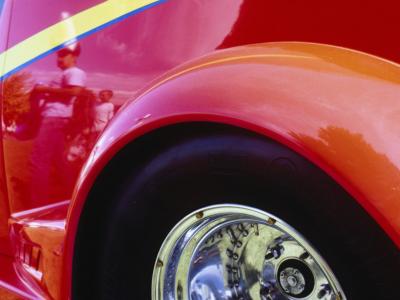
Paint functions as the primary barrier to protect car bodies from penetrating contaminants such as moisture, rust, UV light, bird stains and oxidation. Car body paint can also be damaged by scratches and marring impacts from other objects. Different compounds need to be used when buffing and polishing car paint, since they are specific to different levels of damage. A vehicle owner can successfully use compounds if he knows which ones work best for each stage, and its respective application process.
Compounds come in creme or paste form, designed to be applied directly to automotive paint by hand or with the use of an orbital buffer. Cutting compounds come in various grades or grits, and are used in the first stages of removing damaged, scratched or glazed paint. Cutting compounds are routinely used after a fine-grit hand-sanding. Cutting compounds have abrasive fibers and particles that cut into paint's topmost surface, to remove very thin paint layers. Polishing compounds have the least abrasive fibers and particles, and are used to bring out a high-gloss finish. Polishing compounds frequently include waxes or sealers.
Extra- or heavy-cut cutting compounds contain the heaviest abrasive particles to penetrate very deep into clear coat or non-clear coat paint layers. Extra cut compounds work best on very heavy accumulations of oxidation and UV light fading, when the entire vehicle is affected. They are also used to remove deep scratches in localized areas where the scratch has not intruded into the primer coat. Extra-cut compound functions well for removing embedded stains such as bird, berry and tree-sap stains. Extra-cut compound is best used with a matching coarse-grit, or heavy-cut cutting pad, made of fibrous wool strands, although heavy-cutting sponges and cloth pads are also available.
Medium-grade cutting compounds contain smaller abrasive particles in their formulas, making them less aggressive than extra-cut. They work best on average accumulations of oxidation and UV light fogging, where the paint has not been damaged to great depth. Although often used as a second step after extra-cut compound cutting, the medium-grit compound removes medium and deep scratches well without intruding too deep into the paint. Medium-grade compounds do well at removing surface mars that sit atop paint layers. They are used with matching medium-cut sponge, wool or cloth pads. They can be applied with an orbital buffer or by hand.
Fine-cut compounds contain fewer abrasive particles in their formulas, compared to the medium-cut. This makes them less aggressive for the last stage in cutting, after extra- or medium-cut. Fine-cut compounds will bring out nearly all of the high-gloss shine and gloss in the paint's surface, whereas the extra-cut and medium-cut compounds might leave a hazy or foggy surface appearance. Fine-cut compounds remove light scratches, thin accumulations of UV hazing and oxidation, as well as shallow stains. Fine-cut also removes old wax and sealant without penetrating deeply into clear coat or paint. Fine-cut compounds are used with matching fine-cut buffing pads -- either wool, cloth or sponge.
Swirl remover, sometimes called "ultra-fine-cut" is a specially designed formula of oils, cleaners and micro-thin abrasive particles, and is used as an optional last stage of cutting. Swirl remover can smooth out 1,500- to 1,700-grit sanding scratches. Swirl remover excels in removing slight paint imperfections like spider webbing, orbital swirls (dark cars) and light scuffs, which are invisible until illuminated with an ultraviolet light. Swirl remover abrasive particles break down as they create heat and friction, until they become micro-fine particles. Swirl remover is applied with either a fine-cutting pad or a fine polishing pad made from cloth, sponge or wool.
Polishing compounds are used as the last stage of bringing out the paint's luster and gloss after cutting. Polishing compounds can use very tiny abrasive particles and cleaners, or contain a wax and sealer combination. They function like swirl remover, aside from the extra sealant or protectant used as a barrier against UV light damage and oxidation. Some polishes contain no abrasives and use organic chemicals, cleaners and oils to attain a high gloss. Fine polish compounds require low-pressure application with fine polishing pads -- orbital, cloth or sponge -- or can be applied with microfiber towels by hand.
Wax and sealants remain the last stage in paint finishing. Heavy waxes, like Carnuba, buff well into the paint and cover the smallest micro-pores and imperfections. Waxes coat the paint completely, guarding against moisture, oxidation and UV light penetration. Sealants, or wax-sealant combinations, use additional organic or silicone chemicals, to provide the same covering and protection as a heavy paste or creme wax. Many wax-sealant compounds are made from synthetic chemicals, depending upon the formula of the manufacturer. Waxes and sealants are often applied by hand, but can be applied with orbital buffers equipped with very fine polishing pads.